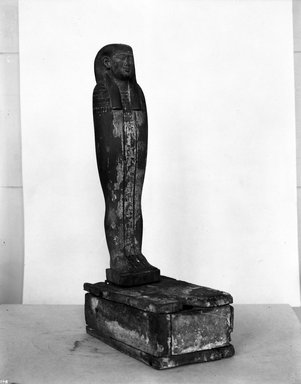
Medium: Wood, plaster, pigment
Geograhical Locations:
Dates:305–30 B.C.E.
Dimensions: Figure: 17 1/8 x 3 3/4 x 2 3/8 in. (43.5 x 9.5 x 6 cm) Base: 2 15/16 x 5 5/16 x 9 13/16 in. (7.5 x 13.5 x 25 cm)
Collections:
Accession Number: 37.1377E
Image: 37.1377E_NegA_glass_bw_SL4.jpg,
Catalogue Description: Mummiform figure with wig-cover, unbearded. No indication of arms. Thin plinth under feet and beneath it a cubical block for insertion in the pedestal. The figure wore a bead-collar which disappeared under the wig behind; that is, was represented as longer like those worn in life, instead of stopping on shoulders. Good, close-grained wood of pleasing light-brown color. Presumably the base once contained a papyrus or mummied animal. Men-zed–hor the name – no parallels, whereas Zed-hor is an exceedingly common name. Almost entirely gone but enough remains to establish that the mummy wrappings were represented as white, the face, ears, and throat were gilded. The inscription is black, the lines bordering the inscription were once dark blue and the wig cover was solidly painted in the same color except for the strips at the bottom which were white (both on shoulder-tabs and behind); the color now green was in all probability originally blue. Corners of mouth raised. Has the typical expression of later figures. Eyebrows and eyelids delicately carved. Aside from the face, the best of the carving is on the lower part of the figure. The knees, calves, ankle-bones and heels are skillfully indicated through the mummy wrappings, while the breast is quite formless and the arms are suppressed entirely! A box with two compartments, the smaller to contain the dowel of the statuette, the larger a chamber for a smaller, mummy (?). Put together of a number of pieces of wood. The top was made of 3 pieces of board the joints running diagonally. The bottom was made of two pieces, joints running diagonally pegs lying horizontally hold two pieces together between them the bottom sides, the interior partition, and the pegs are driven in diagonally, a few lie horizontally connecting the boards of floor, each of one piece of board, are inclosed, and the whole is pegged together. The boards vary in their thickness from 5 mm. to 2 cm. Holes in the wood have been filled in with plaster. The wood is soft and now very dry and much split. The whole was originally plastered over, largely hiding the pegs and joints and painted. Traces remain of pink-yellow color and green borders inclosed in heavy black lines, on the front and sides. The back has lost all its paint. On the top the remaining plaster is so begrimed that the color is no longer distinguishable. This piece illustrates well the economy the Egyptians used with their wood. In the cavity were found fragments of brown stained mummy-wrappings bits of plaster from the exterior of the box, but no animal or papyrus remains. Condition: Inscription too damaged to be legible. The headdress, pedestal (found later see separate ship), and tip of nose are missing. There is a deep crack running downward more than half way from the throat at the feet. An imperfection in the wood on top of the head was filled in with plaster. The hole to receive the dowel of the headdress is now filled with black wax or bitumen and has a wooden pin sticking in it.